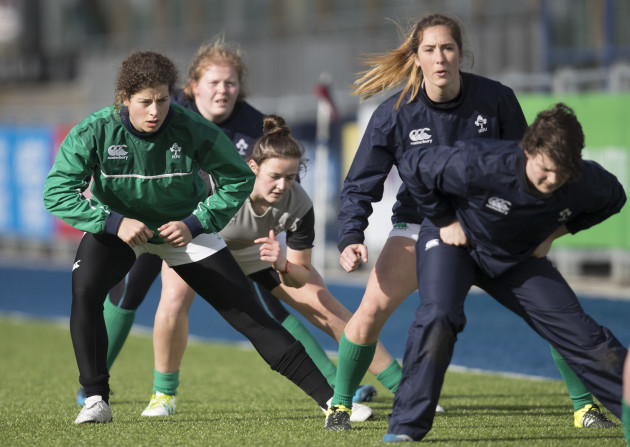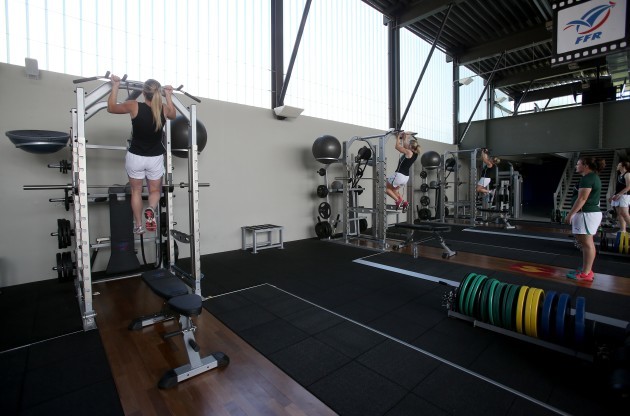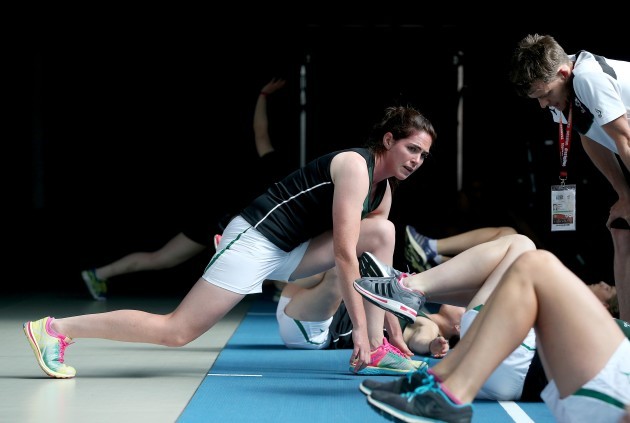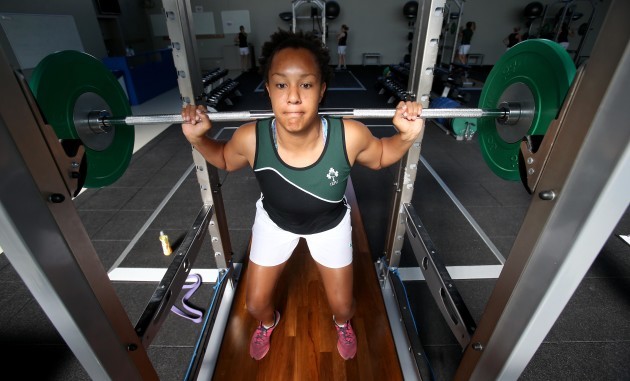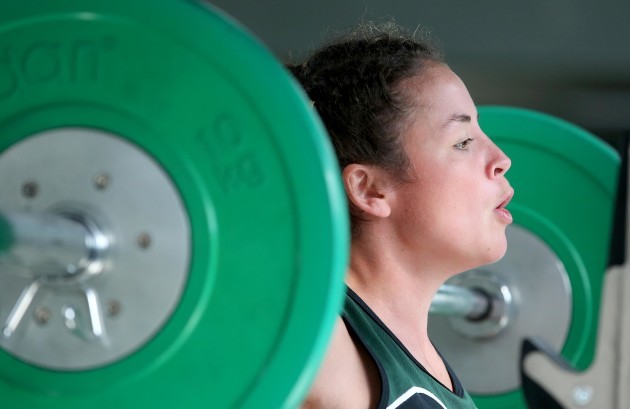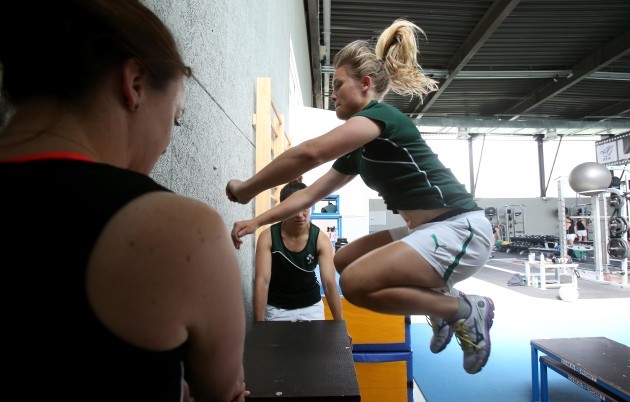BY THE TIME Ireland run out for their opening Women’s Rugby World Cup match against Australia in UCD, you’ll probably have noted that many of the personnel involved have labelled this squad ‘the best-prepared’ group this country has ever sent to the tournament.
That statement shouldn’t be feared as some boastful unfounded claim that is building them Ireland up for a fall. It’s an irrefutable fact based on hours, resources and indeed cold hard cash, invested in Tom Tierney’s squad.
The tip of the iceberg, the clearly visible aspect of that comes in the form of the contracted dedicated Sevens players who have bolstered the ranks in training and matchday squads when tournaments come around. Alongside them, their amateur 15s-focused team-mates, who can now take aim at the elite world level from a rock solid platform.
“They’ve had more sessions and more training weekends over the last 18 months than they’ve ever had,” notes strength and conditioning coach Ed Slattery, a key component of that structure.
The preparation has been a lot more robust and a lot more defined than it has ever previously been with the women’s rugby team.”
Slattery is responsible for overseeing the physical preparation of the 28 women in the WRWC squad, and the dozen or two more that were vying to be involved through the last three months of training. Ordinarily, that means taking charge of sessions in the regional training centre in Dublin – complete with 6am weekday starts.
Now and then, he’s up and starting the car by 3am to check in with the centres in Limerick, Cork, Galway or Belfast. Though the diligent network of coaches ensure that such midnight runs are more protocol than necessity.
Sports science, you see, is not a perfect science. One size fits few, and plans require constant tinkering and adjustment. Because living breathing bodies can’t be held to rigid templates for very long.
As the squad enters their pre-World Cup training camp in Fota Island this weekend, Slattery is keeping close tabs to see how each player is reacting to his efforts to taper their workload so that they will arrive in the Belfield Bowl on 9 August in peak condition. At least now that he has the group in one place it’s become slightly less complicated.
Frequency
“Tapering is hard to do in a team sport. Most of the research is based on dealing with an individual. When you’ve a team sport there are so many issues to deal with… you’ve 28 individuals who are trained in different areas, who have different jobs, have to travel different distances, who all have different sleep patterns, different nutritional patterns, different recovery options.
“So it’s hard to taper, but what we’ll do it look to reduce the volume by 30 to 50% over the next two weeks. But we’ll keep the intensity quite high and we’ll keep the frequency in training.
“So we don’t necessarily train less, or train easier, but we’ll train shorter. Rather than doing an 80-minute session, we’ll pull that down to 60 or 50 minutes, but with a quite high-intensity burst within that.”
That comedown from the peak workload began a fortnight ago. It was a reduction that was hard-earned by the women being put through the wringer. Following the loss in the Grand Slam decider against England on St Patrick’s Day, the players had three weeks to rest, recuperate and re-set all targets before going back into training in April.
In addition to their midweek pre and post-work training sessions, since May there have been eight weekend camps with the entire squad gathered in Abbottstown. It’s there that Slattery and the rugby coaches have really been able to put players to the test.
“Typically Saturday, we’ll look to get at least one high intensity session. We’ll fitness test them and then have one session that would be a mix of high-intensity rugby with the coaches, paired up with a fitness blast with me. They might spend five minutes doing conditioning with me, then go back in slightly fatigued into a rugby setup, they’ll be challenged in a high intensity rugby setup. (We’re asking) can they go through that fatigued state, refocus their minds and apply themselves properly in the rugby setting?
“The second session tends to be lower intensity. That’s when we’ll do unit work: forwards will do line-outs and scrums, backs will work through their bits. Then recovery in the evening.
“If it’s a high-intensity weekend the Sunday will be similar. Or if we want lesser intensity we could just stick with team-play style sessions.”
A native of Clare, Slattery previously worked with both codes of Tipperary minors as well as Cashel RFC and Munster academy before pulling on the IRFU tracksuit before the 2015 Six Nations success. As well as overseeing the 15s’ physical preparation he is also on hand to help Marian Earls out with the Sevens setup. So there’s no barrier to cross-communication with the women involved in both the short and long form of the game.
“We would keep close contact with Marian and tailor girls’ weeks. So if they’re going to come into camp with us they would most likely be given the Friday off, manage her load that way. As of (this week) the Sevens players who will go with the 15s, come under my programme. They’ve been training most days already. Physically they’re pretty much ready to go.”
For the women who only play the long form of the game, match fitness is harder to come by. Tierney will line his squad out against Spain this week for a third warm-up of the summer, but not being a Test match, Slattery ensures in-game challenges are replicated as much as possible in training.
We’re fairly conscious of what’s ahead of us. the World Cup is going to be pretty intense with a game every four days, so we need to expose the girls to as much high volume and high intensity as we can. It’s been quite a unique challenge in that we haven’t had many warm-up games, but we’ve had a lot of work at high intensity to prepare them as best we can.”
Long before they hit the sunny training fields of Fota Island this weekend, Slattery had drawn up a plan with Tierney and director Anthony Eddy. The plans are full of pain-staking detail and methodology, but they must also be disposable when the need inevitably arises.
“We reviewed the November internationals and the Six Nations and, from an athletic development point of view, what areas were the team lacking in and what could we do to improve that? First, we chase the general qualities that would serve as the building blocks to to give the players the capabilities to get more specific. As we go from that sort of general training, we start to build on what we want to focus on.
“Physicality was an issue we wanted to address. We felt we improved in the Six Nations we wanted to keep improving. In that sense, we started introducing more rugby specific physical work as we go through the season.
“Now we’re at a point where, in the gym, we’re being really specific: it’s power work, max strength work and conditioning-wise the sessions are completely based off where we think they’re lacking.
“We’ll base that on fitness test results, we’ll base it on game footage, we’ll chat to the rugby coaches. So there are probably three or four variations of sessions going on each night. When I take the girls tonight there will probably be four different sessions happening simultaneously. Because that will be specific to that player.
It’s not a one-size fits all, you develop your programme, but then you sit down and say: ‘player A can do this, player b can’t do this’. ‘Will we change the extras here, the reps here?’ Make it specific to them as we can.”
Specificity, however, is all the more difficult when players don’t have the luxury of being full-time professionals. From Gardai to doctors to sports organisation and development roles, players have their plate full in and out of training times. So while they have never had as much contact with coaches – skills, as well as physical it must be stressed – a serious amount of responsibility remains firmly on players’ shoulders.
Slattery has seen the graph and the numbers point in the right direction, signalling the squad have more than held up their end of the bargain. Rugby’s not all about the number on the bar, of course, but it comes in handy now and then.
“We have some big lifters. We’ve some girls who will be up near 1.8 or nearly two-times body weight in squats, which is quite impressive. A couple of are competing on the leg press at the minute and they’re up in the mid 200s. There is nice competition at the minute, girls are pushing quite hard.
“The goal for them would be up around 1.7, 1.8 bodyweight in squats. Benchpress, they should be aiming for bodyweight and above. We’ve been lucky that they’re very focused. We’ve been re-setting 1RMs (one-rep maximum) for them nearly every month. They’re training hard in fairness to them.
“Even up to last week, the girls were at quite a high volume. The sessions were intense, tough going and the girls even felt – they felt fit, felt strong – but they were waiting for that little break. We trained the other night and the session was 40 minutes done and dusted, including warm-up, cool-down. But it was an intense 40 minutes. That’s the way we’ll carry on to the World Cup now.”
One 40-minute window at a time.
The42 is on Instagram! Tap the button below on your phone to follow us!

